How To Make Money In Armored Core 5
The post-obit information is "gray area" content, meaning that the information may non have been verified, and the format of the writing may not follow quality standards. It could likewise exist original research by fans. What is written beneath may even be speculation or mere opinions, or both. Read at your ain risk.
The Offset Generation - AC1 to Primary of Arena
Examples of Get-go Generation Armored Cores: Black Dragon, Nine-Brawl, Vixen .
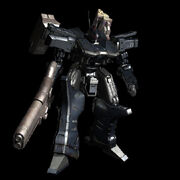
A starting time generation Armored Core, with laser rifle, verticle missiles, laser cannon, and laser blade.
The Kickoff Generation of Armored Cores set the standard for all futurity Armored Cores to surpass.
While limited in terms of variety in comparing with later generations a First Generation unit notwithstanding had a wide selection weaponry, and made up for lack of volume by the sheer ability they possessed. Many weapons were capable of annihilating ACs with only a few blasts, such as the infamous Moonlight and Karasawa.
Mobility wise, they were very express, with only a single or dual booster available for movement. While moderately quick, information technology was predictable and without other secondary mobility options other than walk.
The First Generation is also known to accept the virtually offshoots and branches of Armored Cores. At that place are three main types beyond the start original regular Armored Cores:
- General Purpose Armored Cores (GPAC)
Scaled downwards versions of the AC, GPACs were hybrid MT/ACs which were created for mass production. They were very fast and capable of boosting, and had bones weapons such as the bazooka and laser blade. While not equally powerful as a regular Armored Core, their swift speed and loftier operation made them dangerous in big numbers.
- Mass Productions Armored Core (MPAC)
While the GPAC was a scaled downwards version of the Armored Core meant for mass production, the MPAC was a regular Armored Core that was "scaled upwardly" and so to speak to be in a higher place the capabilities of a regular unit of measurement. The only real difference is that the MPAC was internally modified in some style to enhance its abilities. Despite this the unit does not have Human PLUS and also like the GPAC, is much less durable. Examples include the Swift and Spiteful.
- Custom Armored Cores
Whereas an ordinary AC would exist composed of multiple mass produced parts, the Custom was produced specifically every bit a single ready of parts custom designed by a corporation and was never reproduced. Custom ACs ofttimes were much more powerful than ordinary Armored Cores, only are also considerably rarer. The ii most prominent examples are the Ac Vixen and Nine-Brawl Seraph.
Other Appearances
The Kickoff Generation was as well unique in that information technology was the only generation to announced outside of the original games it appeared in. Specifically, the First Generation appeared again in Armored Core 4 and Armored Core: For Respond as a standard enemy, called Normals, to underline the extreme superiority of the Fourth Generation Armored Core. Despite their name, they are more akin to MTs every bit they are standardized and accept little departure between models other than weapon swaps.
Weaknesses
The drawbacks of the First Generation Armored Cadre were readily apparent as one was used; the primary method of thrust, the boosters, did non provide any method of bursting in speed, and made rapid dodging maneuvers ineffective. Also, although First Generation Armored Core-form weaponry was effective against other Armored Cores of the same generation, and bottom enemies, information technology but did not have the stopping power to fight college-generation Armored Cores, as demonstrated by the Fourth Generation Armored Core'due south power to eradicate whole squads of Offset Generation Armored Cores while taking minimal damage itself.
Another key disadvantage that would conduct on until the Quaternary Generation is the lack of a speed command; that is to say, the ability to stay at a certain speed. Generally speaking, an AC had only ii speeds: absolute standstill or accented maximum; in that location was no mode to allow the pilot accommodate in whatever form and was merely capable of reaching its maximum speed. The only known work effectually to this was "bunny hopping," activating the booster for a moment to jump and continue going.
Although it had perhaps some of the most powerful weapons, some other event the Starting time Generation suffered from was the inability to utilize more than one weapon at time. This would later be rectified in the 3rd Generation and all following ones.
The 2nd Generation - AC2 to Some other Age
Examples of 2nd Generation Armored Cores: Providence, Wonder Raid, Judas
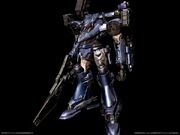
An example of a Second Generation Armored Cadre: a standard biped with Second Generation Karasawa laser rifle, free energy shield, AM extensions, multi-warhead missile launcher, and light amplification by stimulated emission of radiation cannon
The Second Generation Armored Core was a significant milestone in Armored Cadre technological advancement; although weaponry made relatively little progress in terms of power, the multifariousness of weapons available increased dramatically. Several key advancements in mobility and weapons-placement made information technology the template for every other generation of Armored Core after it.
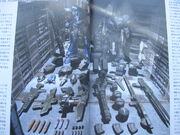
Example of the broad variety of armaments available to 2nd generation Armored Core.
The post-obit improvements were made from the Outset Generation to the 2nd Generation:
- Over Boost - Arguably the most of import improvement the 2nd Generation possesses over the Get-go Generation. Overboost is a larger, more powerful, burst-blazon booster mounted in the dorsum of the Ac's cadre. When active, plates or panels on the back of the Armored Core will open up to reveal the overbooster(s), which volition accuse briefly earlier explosively accelerating the Armored Core to speeds approaching 900mph (approximately Mach 1.fifteen), depending on the core and the overbooster. This alleviates the trouble of the Armored Cadre'due south relatively tedious (300-500mph) average speed when using standard heave. The obvious drawback of overboosters is the massive amount of energy tuckered when in apply.
- Extension Weaponry - The other extremely important advocacy of the 2nd Generation, extension weapons are mounted on the Armored Cadre's shoulders. When activated, they perform whatever chore the weapon is designed for, usually mundane and non-offensive, though offensive weapons exist. Extension weapons include relation missiles, which, when active, burn missiles simultaneously with any missiles fired from the back until the ammunition is depleted; anti-missile systems (either anti-missile missiles or lasers) which target entering missiles and shoot them down with more frequency and accuracy than the cadre-mounted anti-missile gun; directional boosters, which spontaneously and violently push an Armored Core in a predetermined direction (backwards, down, and in a 90 degree turn); and energy or solid-armor shields.
- Inside Weaponry - Weaponry mounted on the inside of an Armored Core's core, inside weapons were unremarkably auxiliary in nature, and often indirect. Inside weaponry included impaired-fired bombs (both solid and free energy based), which were launched blindly backwards from the Armored Core, and all-time used for bombing targets from the air; mine layers; ECM makers, which placed ECM pods which disrupted radar; missile decoys, which were static decoys which attracted enemy missiles; a backwards firing vulcan (chain) gun; and an orbit cannon maker, which created a minor, stationary light amplification by stimulated emission of radiation turret.
- Radiators - An interesting addition to the Second Generation, the radiator's introduction in Armored Cadre ii marked the beginning of the heat management arrangement. With this addition, all weapons generated some amount of heat on bear on; the radiator existed to practice away with said rut. However, the heat did no damage unless the Armored Cadre overheated, in which example the Armored Core would have damage until the heat is dispersed. Strangely, the damage incurred was minimal, and information technology was quite feasible to only use the basic radiator.
- Hover-Type Legs - A new leg type, hover legs served as the opposite of tank legs. Where tank legs are wearisome, cumbersome fortresses of armor capable of supporting heavy cannons, hover legs were calorie-free, agile platforms that allowed Armored Cores to motility extremely rapidly. Hover legs, every bit tin can be inferred by their name, were substantially hovering platforms which the Armored Core'southward cadre was mounted on, giving the Armored Core a resemblance to a mounted knight of the middle ages era of Earth.
Overall, the Second Generation was one of the most critical of all the generations, in terms of the precedents it prepare. The overboost and extension weapons became staple functions of the Armored Core, and exist today in the 4th Generation. The within weaponry and energy shields lasted for several more generations, and were the inspiration for other types of weapons after on. And the radiator, though relatively minor in the Second Generation, would become uncommonly important subsequently on. The Second Generation was largely the foundation upon which all other Armored Cores are built on, more so than the Get-go Generation, making it one of the well-nigh important generations of all-time, and a symbol of the Armored Core franchise.
Weaknesses
The drawbacks of the 2d Generation were not as overt as the Outset Generation, with the mobility problem alleviated somewhat past overboosting and the combat dynamics improved with the addition of extension and inside weapons. However, this led to increased weight that had to exist supported by the legs, and, with the addition of the radiator, meant there was less overall room for weapons. The radiator became, essentially, dead weight, until afterwards, when was used to completely change the balance of the games and alter the mobility available to the Armored Cadre. Despite this, the 2d Generation as a whole presents a stable, consummate instance of Armored Cadre technology.
The Third Generation - AC3 to Concluding Raven
The Third Generation is split up into two groups:the "early on" period consisting of Armored Core 3 and Silent Line, and the "late" period consisting of Nexus, Formula Front, Ninebreaker, and Final Raven. with fundamental differences from each.
The Early-Tertiary Generation - AC3 to Silent Line
Examples of Early Third Generation Armored Cores: Infinity, Mystery, Arcadia, Painkiller
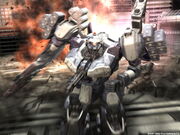
An example of an Early on Third Generation Armored Core: a standard biped with AM extensions, a grenade launcher, machine gun, laser blade, and modest missile launcher.
The Early Tertiary Generation Armored Cadre was a huge spring in terms offensive ability, though mobility was not improved profoundly in the transition from Second to Third Generation.
The following items were added to the 3rd Generation Armored Cadre:
- Exceed Orbit - A new blazon of core (equally opposed to overboost cores) which possessed one to 2 small, hovering drones, each of which fired some class of projectile at any enemy inside range. The type of shot (energy or solid) depended on the core, and the power corresponded to the core weight-classification (calorie-free had automobile gun/free energy machine gun EO, medium had rifle/laser burglarize EO, and heavy had hi-laser/linear gun EO). Solid round EO became useless later the ammunition was depleted, the cadre simply becoming the same equally a core from the Kickoff Generation, while energy EO regenerated its ammunition over time, a significant advantage in its favor.
- Inside Weapons - Within weapons were moved to the inner shoulder, instead of the core. New types of weapons included napalm rockets, which set enemies on fire, ECM rockets, which jammed enemy electronics, and anti-generator rockets, which adversely affected enemy generator's upon bear on.
- Left-Arm Weapons - I of the biggest improvements made to the Third Generation Armored Core was the ability to dual-wield weapons. A variety of weapons existed for the left arm, usually weaker (relatively) versions of weapons available to the right arm. This is not to say that shields and laser blades weren't yet available, however, and the choice was purely academic and could vary from player to player.
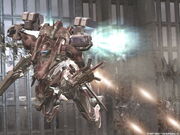
Another case of an early on 3rd Generation Armored Core: a lightweight biped with a laser rifle, light amplification by stimulated emission of radiation blade, multi-missile, multi booster, and Eastward.O. core.
The Early Tertiary Generation was very important, because it was the offset generation to include left-arm projectile weapons. However, other than an increment in weapon types and the addition of the left-arm gun, the Third Generation was non the cosmic leap the 2nd Generation was. In addition, the howitzer, an of import (at to the lowest degree in the case of the left-arm versions) weapon would only last for this portion of the generation, being removed in Armored Cadre: Nexus for unexplained reasons.
The Late-Third Generation - Nexus to Terminal Raven
Examples of Late Tertiary Generation Armored Cores: Foxeye, Oracle, Fascinator, Dual Confront
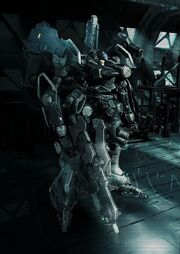
Example of a Late Third Generation Armored Core: AC Oracle, equipped with a linear rifle, linear cannon, micro missile launcher, micro missile extensions, and Fourth Generation Moonlight light amplification by stimulated emission of radiation blade.
The Late Third Generation of Armored Cores stood in stark contrast compared to all other generations; where every other generation improved largely on the previous generation, the Late Tertiary Generation took several leaps backwards in terms of ability for the Armored Core. Nevertheless, this weakening was actually only practical largely to the player-controlled Armored Core, making the games much harder during this generation. This was because of the OP-INTENSIFY-or more accurately, the lack thereof. Some enemy Ravens nonetheless enjoyed this reward, but the player no longer had access to this office.
The other significant changes that occurred dealt with the Air conditioning radiator and rut direction system. Firstly, it was decided that when an Air-conditioning overheated, it would need to use large amounts of energy to ability the radiator to cool downwards. Secondly, information technology was decided to raise the heat caused by all weapons dramatically (energy weapons specifically received increased heat output, besides every bit some loftier burn-rate weapons, similar machine guns), making the energy bleed relevant. Lastly, boosters were altered then that they use generated estrus. Thus, it became incredibly difficult to create a long-term flight-capable AC, equally information technology would constantly run out of energy and be grounded. The higher-level AIs were largely immune to this, as their innate OP-INTENSIFY powers gave them astonishingly increased radiator ability.
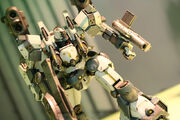
An case of a Late Third Generation Armored Core: Ac Foxeye, a heavyweight biped, equipped with the Fourth Generation Karasawa how-do-you-do-laser burglarize, a grenade rifle, and mutli-burn down back missiles
Ane notable thing nigh the Late Third Generation is that it saw the addition of many "legacy" parts. That is to say, many popular and well-known parts from the previous generations were re-added in this generation, with appropriate balancing changes to fit with the other parts. Included parts are the FINGER multi-butt machine gun, Stinger of Armored Core: Project Phantasma's double bladed light amplification by stimulated emission of radiation blade, and the frame parts to build the encompass ACs of Armored Cadre 2 and Armored Core 2: Another Age, among several others.
Despite the histrion being more often than not handicapped during this generation, it was all the same the highest development of the "Normal" Ac, having access to the widest variety of weapons and equipment.
The Late 3rd Generation provided the following changes:
- Hanger Cores - Probable the most important change to the Late Third Generation Armored Core, hanger cores added the ability to bring additional arm weapons into boxing. Included in the weapons available are pocket-size, handheld pistols, machine guns, pulse rifles, plasma cannons, and other basic armaments. The hanger core could overlap with an overboost cadre, giving both abilities at once, but never with an exceed orbit core.
- Radiators - The radiator, as noted higher up, was made significantly more important to the player in the Tardily Third Generation. A expert radiator was admittedly necessary to an AC'due south full general movement, for without one the player would constantly be grounded due to lack of energy. This meant that at that place was much less room for weaponry on the player's Air conditioning, due to that weight being taken upwards by the improved radiator.
- Tuning - The Late Third Generation saw the add-on of tuning. Most every category of office, besides FCS and weapons, was given 10 points to spend on tuning and several categories to ameliorate. One could choose to dedicate some points to each category, or all of them to ane. In this way, a thespian could slightly amend his base of operations parts without actually switching them out.
- Weapon Magazines - Late Third Generation weaponry received the interesting and less drastic change of magazines. Previous Armored Cadre games had weapons which kept firing until they completely emptied of ammo, a class of "bottomless mag." From this betoken forward, Armored Cores reload some kinds of solid round weapons magazine-by-magazine; a automobile gun, instead of firing 700 rounds directly, might now burn down seventy earlier reloading. Many types of weapons were affected by this change, though normally they were loftier ammo weapons, and always solid round.
The Late Third would see the Normal out of dominance as the virtually powerful weapon on the battlefield. In that regard, information technology does well, outfitting Air-conditioning'south with the largest armory ever in whatever AC game. However, it was besides very detrimental to the player's power to fight effectively, while allowing the AI to all the same use many bonuses from older games the player could not. I could argue that this allows the AI to challenge the player on fifty-fifty basis, while another could say that this was an unfair and "cheap" way of making the AI meliorate.
Regardless, the Late Third Generation, despite many weaknesses on the player side of things, was hands the strongest Normal generation if one takes the AI's abilities as canon. In that regard, the Late Third Generation Armored Cadre was virtually monstrously powerful, and several Late Third Generation Armored Cores might even be plenty to give an early Fourth Generation Armored Core pause in battle. That said, the Tardily Third Generation does not announced in whatsoever farther games after Last Raven, so this theory could not be put to the test.
Weaknesses
There were few drawbacks of the 3rd Generation; weapon types were plentiful, there were two types of cores to choose from, and the combinations of parts that could be made were shockingly numerous. A small weakness can be noted in the left arm weapon; although it now provided an actress weapon beside the blade, information technology was difficult to utilise. This is mostly attributed to the fact that the left arm was always in the default standby position, thus in gild to utilize it, it required a moment to lift the arm up to prepare it in firing position earlier firing. This meant that there was a filibuster from the time the weapon was triggered and when it was fired. The left-arm weapon also had no targeting of its own, meaning that if the right-arm weapon was wearied of ammo earlier the left-arm weapon and discarded, the left-arm weapon would simply have to exist fired blindly.
Yet, despite these problems, the Early on 3rd is still considered the Gold Age of the Armored Cadre technology. This would be short-lived, though, as the Late 3rd Generation rebalanced the game and reduced the overall effectiveness of the AC every bit the thespian could utilize it.
The Fourth Generation - AC4 to For Answer
Early on Fourth Generation - Pre-AC4
Examples of Pre Fourth Armored Cores: 00-Aretha, 002-B
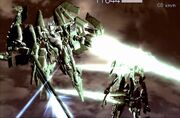
Example of an early Fourth Generation Armored Core: laser rifle, Kojima cannon and Kojima blade.
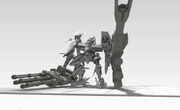
Another example of an early Fourth Generation unit: quintuple gatling guns, mega Plasma cannon, and prototype Assault Armor. Quite possibly the offset Next in existence and dwarfing all others in terms of top.
Preceding the the AC4 era Armored Core, these units are the starting time Adjacent models in the AC4 Universe. They are the first units to contain the Kojima engineering science also equally other prototype designs, and besides have the greatest variance in size; a showtime for an Armored Core series, these NEXTs are non-customizable and have a fixed set of parts and weapons. Despite being an older generation, these units are easily simply as powerful, if not more than so than mid Fourth Generation units; information technology is merely in the latter half of the AC4 universe that the Fourth Generation NEXTs begin surpassing them. Due to their unstable and dangerous nature, this line of Armored Cores is discontinued shortly after their creation. These machines would after be configured in Armored Core: For Answer to exist entirely democratic.
Mid-Quaternary Generation - AC4
Examples of Mid Fourth Generation Armored Cores: Supplice, Cypher, White Glint, Barbaroi
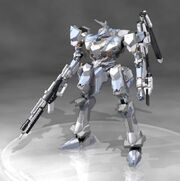
White Glint, an instance of a mid Fourth Generation model complete with assault burglarize, laser blade, and laser cannon.
By the fourth dimension of Armored Cadre 4, in that location are ii distinct classes of Armored Cores: Normals and NEXTs. The Quaternary Generation of Armored Cores, called NEXTs, are the adjacent footstep in Armored Cadre engineering and represent experimentation into new territory. The Quaternary Generation Next provided the following changes:
- Allegorical Manipulation System- A highly advanced and sophisticated piloting organization adult by Professor Jarnefeld and Aspina, information technology gives Lynx'due south a very loftier degree of control over their NEXT. A special psychic trait is necessary for it to be used. The exact nature of the AMS is non understood, simply the descriptions given past diverse characters throughout the game seem to propose that it involves an actual mental link to the vehicle, rather than simply physically piloting the AC. The truth remains unclear as no NEXT's cockpit is ever shown to the player. A possible reason is that the airplane pilot'southward brain is also linked to the NEXT's optical sensors, which would eliminate the need for a traditional cockpit altogether.
- Kojima Generators - Presumably the new energy source for NEXTs, equally opposed to whatever powers the standard Normal, Kojima Generators use Kojima Particles, a highly radioactive and mayhap artificial substance, to generate large amounts of energy. It is not known whether they do this through nuclear reaction or another course of energy generation.
- Primal Armor (PA) - Particle shielding accomplished by "molding" Kojima particles into an orb-shape. This would propose that Kojima particles are related in some manner to plasma, as plasma can be "molded" in a similar manner with magnetic fields. In whatsoever case, Primal Armor serves effectively equally a 2nd layer of defense force for a Next. Without it, they are much weaker defensively and are easily destroyed.
- Shoulder Weapons- The Fourth Generation name for Extension weaponry, this now includes PA molders (which increases PA integrity and strength) and flares (which distract missiles), amidst other new additions.
- Multiple Boosters - A huge bound in terms of mobility, NEXTs had many booster units all over the unit in lodge to not only help execute Quickboost's in multiple directions, but as well to motion with greater precision. Previous Armored Cores only had a pair of main boosters located on the back of the core unit and one on each leg for limited turning power. This addition gives the NEXT superior maneuverability and control in both ground and aerial gainsay.
The Fourth Generation NEXT greatly out-performs every other generation of Armored Cadre thanks to the addition of AMS and Kojima generators, which amazingly increases the ACs' Energy Output; some other cardinal advantage was the removal of the cherry-zone of the generator; rather than shutting down entirely in the face of an energy shortage, a Adjacent will simply momentarily cease energy-related functions in order to chop-chop regain its free energy stores, earlier moving on equally if nix had changed.
One notable change is that Armored Core parts are not individual but congenital from sets. For case the AALIYAH model of NEXT is congenital from parts based solely on AALIYAH based parts. A variant model, the ALICIA is named after its legs but is otherwise the same AALIYAH. Other Adjacent designs are named differently from the "stock" based on a difference in arms. Most Adjacent pilots use a Side by side based on a specific part ready but with customized Air-conditioning weapons.
Also notable is the lack of a radiator system, immigration upwards more space to be used for weapons or heavier gear. Relatedly, NEXTs of the Fourth Generation seem to be able to carry a nifty deal more than previous "Normals," and are significantly larger.
Finally, the left arm weapon has been made completely interchangeable with the right. There is no difference between weapons in either arm, although both arms accept weapons bought in their own categories all the same. Both weapons also have their own targeting, and the latency period between trigger-pull and actual firing has been removed for left-arm weapons.
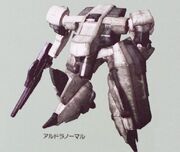
The GOPPERT-G3, an case of a "Normal" Armored Core.
Normals - A term used to refer to older generations of Armored Cores, just also includes models that exercise not use Kojima Particles. Conceived by the companies, they saw heavy utilise along with NEXTS during the National Dismantlement State of war. They are mass production units designed for large calibration gainsay. While nevertheless more effective than conventional units, a Normal is typically completely outclassed by NEXTs. Despite this fact, they are still a mainstay of many of almost companies forces, as NEXTs are presumably significantly more than expensive and much more than difficult to mass produce.
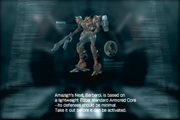
Barbaroi, some other example of a mid Fourth Generation Armored Core NEXT: lightweight biped unit of measurement with assault burglarize, shotgun, and spread missile.
NEXTs - A term for what is considered to be the virtually advanced class of Armored Cores. Based on Normal engineering science, the NEXT's split up classification revolves effectually the utilise of Kojima applied science and Aspina's AMS piloting system to make the already unsafe Armored Cores much more deadly on the battlefield. The Adjacent represents the current high-point of Armored Cadre design, when compared to all other forms of the vehicle. NEXTs are repeatedly shown to be able to wipe out entire armies of lesser Normals and MTs, and merely the most advanced Normals (such as BFF's "Silent Avalanche" sniper squadrons) are shown to be able to compete with them. NEXTs also have the widest range of customization of the Air conditioning generations, but are also notably more than expensive. They are often the deciding factor in battles, and almost e'er the key to victory for the winning corporation in whatsoever major date.
Late Fourth Generation - ACFA
Examples of Tardily Fourth Generation NEXTs: White Glint, Stasis, Reiterpallasch
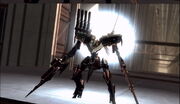
Stasis, an example of a Late Quaternary Generation Armored Cadre NEXT: lightweight biped unit with assault rifle, laser bazooka, radar, and PM missiles.
Encompassing all NEXTs built the decade afterward the Lynx State of war, Late Fourth Generation models are considered to exist the apex in the Next evolution. The ability to Quickboost has been increased several fold with greater efficiency in terms of KP bleed, free energy output, and and overall mobility. The Tardily Fourth Generation besides noted the transition from a footing based unit with limited flight fourth dimension to a more efficient unit with potentially limitless aerial capabilities; whereas in previous generations, an Air-conditioning would lose considerable speed when airborne, a Side by side really gained from it to a big degree.
This gave NEXTs not just the reward of an actress dimension of movement, but also greater overall flexibility and survival rates as it was far ameliorate suited to irresolute combat situations than Normal Armored Cores, which were limited to basic boosting and were essentially stuck to the footing. Weaponry has besides advanced in terms of sheer quantity also as firepower the refinement of Kojima weapons technology. Simply put, NEXT engineering has been refined to the point of perfection, allowing these mechanized one man armies to take on enormous odds (Arms Forts and even armies) and withal come out on top.
The Late Quaternary Generation NEXTs brought forth the following changes:
- Set on Armor - This innovation added a new offensive edge to the Next. Sure Over Boosters were equipped with the power to unleash all of the Air conditioning's Kojima energy at once in a large blast that deals massive damage to anything and everything effectually the Adjacent. The power of the blast depended on the Over Booster, simply even the weaker Assault Armor generators could severely harm an enemy Adjacent. The chief downside of this assault is that by releasing all of a Side by side'south Kojima energy, it leaves them without their Primal Armor for a short period of time, leaving that NEXT extremely vulnerable to heavy artillery fire.
Weaknesses
Despite the new capabilities of the Quaternary Generation Armored Core, in some instances NEXTs lacked features of older models. The showtime and foremost was the lack of a cadre mounted Anti-Missile System. In older generations, most Cores usually had a built in light amplification by stimulated emission of radiation-similar interception organisation which was capable of destroying missiles that came into range; this function had no cost and did not accept any energy. This feature is entirely absent-minded in NEXTs, which may be considered a minor design flaw. However, taking into account a Side by side's superior agility, shoulder-mounted flares and Primal Armor, core-mounted anti-missile systems were essentially supplanted in terms of function.
Another cardinal shortfall is shown in A Nighttime Night's March, in which it is shown that NEXTs also lack night vision capability, which is extremely odd, considering that most other units such equally MTs, Normals, and even tanks had this piece of equipment, meaning that without back up, a NEXT is essentially useless at night and much less effective during adverse weather condition conditions.
Some other problem with NEXTs lies in their Primal Armor. When their Cardinal Armor is agile, a Next is nearly indestructible, only once its Primal Armor is gone, information technology volition have a lot of damage from even modest arms fire. Because of this, NEXTs need to rely on their superior mobility in guild to avoid taking hits that would bleed a lot of their Primal Armor, and must besides exist conscientious when using Assault Armor.
Aside from the lack of night vision, most of the older features missing from the Adjacent were and then because of obsolescence, rather than blueprint flaw. The lack of anti-missile systems were made upward for primarily with Cardinal Armor and superior mobility, and in no style puts a Side by side at a disadvantage against whatsoever previous generation.
The Fifth Generation - ACV to Verdict Day
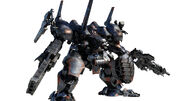
Hanged Man, an case of an early Fifth Generation Armored Core equipped with a Battle Burglarize, Burglarize, Laser Blade and Shotgun
Early Fifth Generation - ACV
Examples of Early Fifth Generation Armored Cores: Hanged Man, Vengeance
Whereas each succeeding generation of Armored Cores was a significant comeback over the side by side (with the exception of the Late Third), the 5th Generation can be better described as 1 office refinement, one part advancement, and one part regression in terms of their overall capabilities.
5th Generation Armored Cores are at present less than half the meridian of the previous generation and are designed to preform well in urban combat situations. Also, dissimilar in previous generations, the Fifth Generation Armored Cores generally work in groups of 2-5 and place emphasis on squad based tactics. The small size of the 5th Generation ACs allows them to apace travel through alleys and other tight infinite, and also means that they tin amend use buildings as encompass in lodge to protect themselves from projectiles.
These units no longer possess a radar system, and is instead supervene upon by Browse Manner, a specialized style that allows an Ac, when used in conjunction with recon units, the power to see opponents on the battlefield, even when hiding behind buildings. It also gives a huge free energy boost, at the price of the ability to burn down weapons while in this mode.
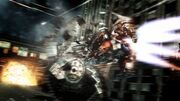
A 5th Generation Ac Performing a "Boost Charge".
Fifth Generation Armored Cores accept also returned to their ground-based combat roots and take limited aerial capabilities, and are not able to fly or maintain top for extended periods of time. Despite this, they take an abundance of motion options, giving them greater diverseness in terms of boost they could use in whatever situation.
Compared to the previous generation, the booster system has been simplified and consolidated; instead of having a multi-booster arrangement, ACs now have a simple, single booster function blazon like to older generations, arranged onto the cadre in two or 4 unit of measurement sets on the dorsum and/or sides. This immune heightened mobility options for AC's of this generation to such a caste that they tin be seen as miniature NEXTs, with only the high energy costs from the above options holding a pilot back from more radical move options.
The 5th Generation brought along the following changes to mobility:
*Normal boost - Normal heave is a default booster function which allows an Air-conditioning to traverse terrain faster than walking. This boost takes no energy, and while airbourne, an Air conditioning will stay aloft for a short catamenia of time, slowing floating back to the ground. Because of its slow nature, its non particularly useful for dodging, merely allows an AC the ability to quietly maneuver in tight spaces.
*Hello-Boost - A very quick outburst acceleration which replaces the Quick Boost of the Fourth Generation simply is slower to reuse. This can range from a short and controlled outburst to a powerful and long lasting one, moving a unit over huge distances.
*Glide Boost - Similar to the Overboost of previous generations, Glide boost is a prowl mode that allows an Air conditioning to travel at a fixed peak only with the flexibility to motion virtually 360 degrees on a horizontal plane. It can be combined with Hi-Heave to increment speed for brusk periods of time. Its master limitation is that it can but be activated on a apartment surface, and not in the air.
*Heave Charge - In essence a melee attack reinforced with boosters (a kick or a total unit tackle). It is an extended Hi-Boost, and will still move an Ac a significant altitude, albeit slower.
*Boost Drive - the ability to leap off building to proceeds more than height or all of a sudden alter directions. Its low free energy usage and versatility gives ACs an edge in combat, allowing them to overtake or flank enemy units almost instantly.
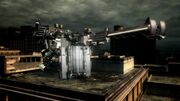
5th Generation Unit of measurement with a Sniper Cannon. The unit is kneeling and has the leg shield deployed.
Weapons take been drastically overhauled likewise; ditching the dorsum weapons system from older games, all weapons are now hand carried, with a weapon beingness equipped on each arm, and ii on hangar units on the shoulder. "Back Weapons" are now classified equally "Cannon Weapons," and require an Ac to enter a stationary "ready" position earlier firing (similar to the old crouch for using the traditional back weapons). Certain legs also receive a defense force bonus while in this fashion.
With precision-type cannons, the Ac must manually aim at its target. Tank legged ACs can use these weapons without entering the "ready" position, making them an ideal choice when considering the use of cannons.
All weapons and armor come in three damage blazon categories: KE, CE, and TE (Kinetic, Chemical, and Thermal). Bullet based projectiles deal KE damage, Chemic/Explosive type projectiles deal CE damage, and energy weapons deal TE damage. This allows Pilots to tailor their Air conditioning to go extremely resistant to certain kinds of weapons. When facing a Fifth-Generation Ac, information technology is strongly recommended to scan them in order to determine which weapons to use confronting them.
The concept of the Hanger has as well be dramatically improved. In previous generations, it was necessary to purge weapons to use the hangars. This is no longer the case, nor needed with the Fifth Generation unit of measurement as they attach to the shoulders via a carousel like mechanism. These hangers also let pilots to store rifles and Gatling gun on them, rather than being express to smaller weapons. Rockets and Missiles are relegated to built-in shoulder units and can be equipped in single or dual mounts, but 2 separate shoulder weapons cannot exist equipped at the same time. The only weapons that require to be purged before using the hangars are cannon type weapons.
A key feature of this generation is their use of Ultimate Weapons, extremely powerful but difficult to employ weapons capable of destroying at least one ordinary target in a unmarried strike. These take the place of the traditional Dorsum Unit of measurement and are extremely heavy. They forestall the use of Hangar parts however.
Tardily Fifth Gen - ACVD
Examples of late Fifth Generation Armored Cores: R.I.P.3/Chiliad, Thor's Hammer, C03 Malicious (Lone Merc)
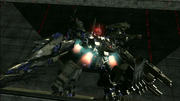
Air conditioning RIP3/K An example of a tardily Fifth Generation Armored Core with a laser rifle and HEAT machine gun
The second one-half of the 5th Generation is similar to the Tardily Third Generation in that information technology saw many changes (nearly negative) to the effectiveness of parts and weapons, but likewise saw a boost to diverse others as well.
Overall, mobility for lighter units were increased profoundly, allowing them an even larger advantage against other units. On the flip side, most heavier units, particularly tanks, became significantly slower with much weaker firepower, making them more vulnerable, less useful, and overall struggle to fight other units.
Energy recovery has been increased beyond the board, enabling ACs to attain new limits of operational time; some ACs are at present able to stay permanently in how-do-you-do-boost while in browse manner.
The Tardily Fifth Generation saw ascension of a few new generation of parts:
Retrofit Parts: based on existing parts, retrofit parts were modifications of regular parts with significantly different stats, giving ACs different specializations and uses.
Weapon Arms: Like past generations, Weapon Artillery practice non offer a lot of armor or AP, but they brand upward for these drawbacks through their destructive power. All fifth generation weapon arms pack cannon blazon weaponry, and permit whatever AC to use them without entering the "set up" position. This ways that Weapon Arms remove the mobility penalisation of traditionally conveying such weapons on lighter ACs. These Weapon Arms too allow ACs to equip regular weapons on acme of the ones present within the weapon arms, making these the most versatile Weapon Arms in whatever AC generation. Weapon arms tin as well allow storage for hand held cannons when the airplane pilot starts using the Weapon Artillery, rather than forcing the pilot to purge these weapons before switching, making them ideal choices for Tanks.
Shields: Making their return after their divergence at the commencement of the 4th Generation Era, shields have been completely revamped. Instead of decreasing the amount of impairment that an AC takes, it has its own AP and absorbs impairment completely until it has been depleted. Much like the damage types it is carve up into three types: KE, CE and TE. Each type has a high single defence force, and low defense force in the other two areas. This means they excel extremely well against their rated damage type, losing lilliputian AP and rarely being dealt constructive harm. Nonetheless, against whatever other damage blazon, they will deplete quickly and will almost always take effective damage. Their portability and usefulness on almost any Air-conditioning makes them a highly used and effective tool.
Weaknesses
One of the important weaknesses of this Armored Cadre generation is their lack of a radar. Its replacement, Scan Manner, does not allow an Air-conditioning to fire its weapon and locate enemies at the same fourth dimension; ACs can still apply boosters while in Scan Mode, and their Boost Charge set on. ACs as well have limited numbers of recons; in one case depleted, Scan Mode becomes significantly less useful as a means to locate enemies.
5th Generation Armored Core besides lack strong firepower alternatives for not-tank legs. Cannon-type weapons exist, merely are limited to apply by a handful of legtypes, and lacks a HUMAN-PLUS solution. This means that overall most units have significantly reduced offensive capabilities. This makes them much more than situational. Cannons must as well be purged in society for an Air-conditioning to switch to a weapon that is existence stored on their hanger, farther reducing their utility. Equally a result of these depict backs, 5th Generation ACs work best in pairs or in groups, with each covering the others' weaknesses.
Despite their weaknesses, a team of well built 5th gen ACs tin handle a fight against North-WGIX or even an Arms Fort if the pilots are skilled plenty.
Source: https://armoredcore.fandom.com/wiki/Armored_Core_(mecha)
Posted by: longdesiblesen.blogspot.com

0 Response to "How To Make Money In Armored Core 5"
Post a Comment